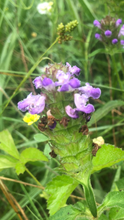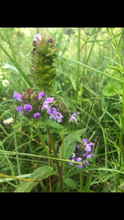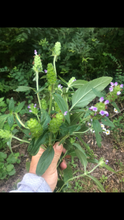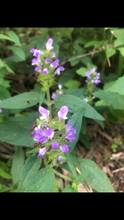Self Heal (Prunella Vulgaris) seed
Regular price
$4.00
Sale
Self Heal - MUST HAVE in your Medicinal Herb Garden.
• Prunella vulgaris
• Family Lamiaceae (Labiatae)
• Perennial
Herb gardeners hold differing opinions about self-heal. Some welcome its cheerful violet flowers in the summer herbal lawn while others revile the plant as a pesky weed of the herb garden or grass-only lawn. Few grow it intentionally in the herb garden, and some may not be acquainted with the plant at all. This situation is a far cry from three and four centuries ago, when herbalists held self-heal in high esteem, perhaps with good reason.
Description
Self-heal, a member of the mint family, looks much like a mint but lacks a minty or other aromatic fragrance. In fact, the plant has virtually no odor. Native to Eurasia, this herb is at home in much of North America and is hardy at least in zones 4 through 9.
Self-heal’s square stems arise from a fibrous rootstock and sprawl along the ground 2 feet or more before turning upward. This habit makes the flower heads appear to be carried on stems only a foot or so high (less in a lawn). The leaves are medium green, opposite, rounded at the base and pointed or blunt at the tip. The edges are slightly wavy or toothed. The lower leaves are stalked, but the two leaves immediately below the flower head have little to no stalk. The stem and leaves are slightly hairy. The flower head is a stubby spike made up of numerous whorls of six florets each. Each whorl has a pair of green-veined whitish bracts beneath it. Each floret has a brownish purple toothed calyx that contains a violet two-parted corolla. The upper part, which is often more intense in color, forms a little hood, and the lower is a three-parted apron, a handy landing platform for insect pollinators. As the flower head matures, the spike elongates but remains more or less fatly cylindrical. At a distance, the flower head looks brown and purple because only some of the florets are open at once. The flowers attract bees and butterflies.
In The Kitchen
Though self-heal is edible, it apparently has few traditional culinary uses. You may soak chopped fresh leaves or powdered dried leaves in cold water to make a somewhat refreshing beverage, but many tastier ones come to mind. The leaves have little flavor at first, but chewing them brings out a slight bitterness. You may serve the young shoots and leaves raw in salads, cooked as potherb, or added to soups and stews.
Medicinal Uses
Self-heal has many common names, most attesting to its reputed curative powers. Hook-heal and sicklewort come from someone’s fanciful notion that the flower in profile resembles one of these tools. Others noted the flower’s resemblance to a mouth and throat, concluding (according to the doctrine of signatures) that it should be used to treat ailments of those parts. The unlikely name carpenter’s herb reflects the herb’s alleged power to “joine together and make whole and sound all wounds, both inward and outward.”
The origin of the generic name, Prunella, is in dispute. It might refer to the purple flowers, but herbalists cling to the theory that it is a variant of Brunella (in German, die Bräune—“the browns”), a kind of bad sore throat that sixteenth-century German soldiers contracted while “lying in camp”. Gerard (1633) described the symptoms as including a “ruggednesse, blacknesse, and drinesse of the tongue, with a kind of swelling in the same,” along with “a continuall ague and frensie.” Rugged, too, was the remedy: a decoction of self-heal taken “after blood letting out of the veins of the tongue” and followed by frequent washing of the mouth and tongue with the same decoction, “and sometimes a little vineger [sic] mixed therewith.” No mention is made of the cure rate. Today, the camp doctor would likely prescribe an antibiotic.
The tannins in self-heal that might have relieved a sore throat might also have been effective in healing wounds and sores. Gerard ranked self-heal and bugleweed (Ajuga sp.) as the two best wound herbs; both contain tannins. Taken internally, self-heal was also thought to alleviate eye inflammations and eyestrain. The American pharmacist and herbalist Ben Charles Harris recommended a decoction of self-heal to soothe the digestive tract during or following an attack of diarrhea.
Self-heal has also been traditionally used for headaches. Gerard noted, “Bruised with oile of Roses and Vinegar, and laied to the forepart of the head, [it] swageth and helpeth the paine and aking thereof.” Today, the herb is known to open up peripheral circulation by expanding blood vessels and thus is used occasionally by European herbalists in treatments for mild headache. However, other peripheral vasodilators such as yarrow, hawthorn, linden, and ephedra have largely replaced self-heal.
In traditional Chinese medicine, self-heal has been referred to as a cooling herb, useful against fevers and liver and kidney disorders and as a tonic.
Self-heal is all but unknown in modern Western medicine, perhaps because more effective remedies abound. Scientists, however, are studying possible antibiotic properties as well as the herb’s ability to lower blood pressure. They have discovered that it contains the antitumor and diuretic compound ursolic acid.
Other research has focused on self-heal’s antioxidant activity. Antioxidants have been in the news lately because of their role in slowing aging and preventing cancer, and natural antioxidants are found in many plants. A recent French test showed self-heal to have one of the strongest antioxidant potentials among the more than 50 mints studied.








